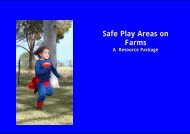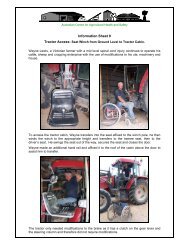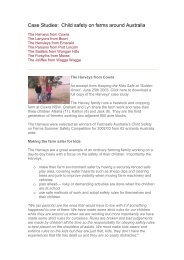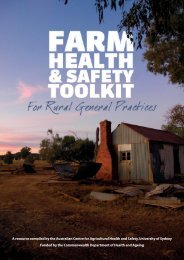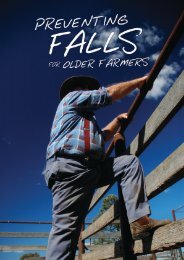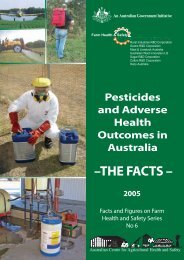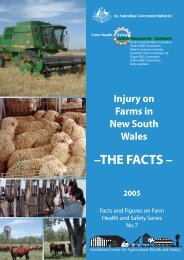Ripper ii Educational resource for primary schools - Australian ...
Ripper ii Educational resource for primary schools - Australian ...
Ripper ii Educational resource for primary schools - Australian ...
Create successful ePaper yourself
Turn your PDF publications into a flip-book with our unique Google optimized e-Paper software.
TOPIC 1: PRODUCTION AND TECHNOLOGY ON FARMSOverview: Children examine the role of farms and rural properties as places where people use <strong>resource</strong>s and technology to create plant andanimal products. Flows and chains are used to clarify stages of production on farms in the local area and / or <strong>for</strong> one <strong>primary</strong> industry in furtherdetail. The role of technology in production is explored through a research project.Teaching strategies ACTIVITIES ResourcesActivity 1: FARMS – PLACES OF PRODUCTIONKeypoint: People work on farms and use <strong>resource</strong>s and technology to produce plant / animalproducts <strong>for</strong> sale. Many products used in everyday life originate from farms and undergo stagesin the production process be<strong>for</strong>e and after they leave the farm.Defining termsand featuresKnowledge andunderstandingShare storiesAnalysisResearchassignment on<strong>primary</strong> productionAnalysisReview the common features of farms. Farms can be home, a workplace, or a combinationof these (eg. rural hobby block, working farm without a home, working farm with a home).Children can:• Describe what a farm is and give examples of different types of farms.• Find pictures of farms and farm products and make into a collage.• Define the following terms and explain / give an example of each in relation to a working farm:Resource, Product, Technology, Primary producerInvite children to share stories about what is produced locally on children’s own farms or farmsthey have visited in the local area. Children can:• List products grown / produced on local farms• Discuss the stages and activities involved in producing this product whilst on the farm• Find out about the stages involved in processing after it leaves the farm.As necessary, review or introduce the concept of flows and chains. If available display anexample of a <strong>primary</strong> production chain, such as in the “Workboot” series. Children can choosea local <strong>primary</strong> industry OR research a particular <strong>primary</strong> industry of interest, focusing onaspects of farm production (eg. use “Workboot” series) and:• Construct a production flow / chain to identify the stages of production on farm• Describe the activities associated with each stage of production on farm• Explain stages of processing after the produce leaves the farm.Magazines,newspapers,cut & paste materials“Workboot” SeriesClass discussionKnowledge andunderstandingMake a posterSynthesisActivity 2: USE OF TECHNOLOGY ON FARMSKeypoint: People on farms work with machines and technology to help them with different stagesof production. Some machines are designed <strong>for</strong> farm production (eg. tractors). Other technologiesinclude electronic devices (GPS), computers and communication tools (eg.two-way radios).Invite children to share about machines and technology used on their farms. Children can:• Make a list of all the machines, equipment, processes or devices that are used on local farms.• Share knowledge about how each one is used to help farm production.• Make a poster about one machine / device used on farms, as part of a “farm technology” displayin the class (eg. tractors, shearing handpieces, milking machines, two-way radios, computers,chemical supplies and delivery systems). On the poster:• Draw, label and describe features of this technology (or part of it)• Describe how the farmer uses the technology in the course of his/her work.• Identify any ‘hazards’ associated with this machine / system.Describe how these are managed to make use of the equipment safer.Cardboard, pencils/ poster paper / cut& paste materials58






